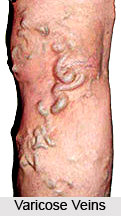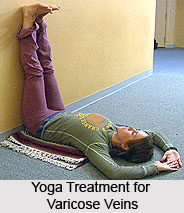 Thin-walled vessels through which the impure blood is carried back to the heart are known as veins. They usually have valves, which regulate the flow of blood towards the heart. Varicose veins are a condition in which veins become enlarged, dilated or thickened. Varicose veins can occur in any part of the body but generally appear on the legs. The veins of the legs are the largest in the body and they carry the blood from the lower extremities upwards towards the heart. The direction of circulation in these vessels is largely determined by gravity. Though there are no mechanical obstacles to blood-flow, it is usually the incompetence of the valve which leads to an increase in intervenous pressure.
Thin-walled vessels through which the impure blood is carried back to the heart are known as veins. They usually have valves, which regulate the flow of blood towards the heart. Varicose veins are a condition in which veins become enlarged, dilated or thickened. Varicose veins can occur in any part of the body but generally appear on the legs. The veins of the legs are the largest in the body and they carry the blood from the lower extremities upwards towards the heart. The direction of circulation in these vessels is largely determined by gravity. Though there are no mechanical obstacles to blood-flow, it is usually the incompetence of the valve which leads to an increase in intervenous pressure.
Varicose veins are dangerous and have an unsightly appearance. Varicose Veins are the dilated and knotted veins, particularly at the back of the legs. A blood clot within a large, greatly dilated vein may break away and move toward the heart and lungs, causing serious complications. Varicose veins are about thrice as common an occurrence in women as in men, both in the middle age or elderly people. In rural undeveloped societies this disease is very rare.
Symptoms of Varicose Veins:
Swelling along the course of the veins is the first symptom of varicose veins. Muscular cramps and a feeling of tiredness in the legs behind the knees may follow this. In some cases, the normal flow of blood towards the heart may be reversed when the patient is in an upright position. This results in venous blood collecting in the lower part of the legs and the skin becomes purplish and pigmented, leading to what is known as varicose eczema or varicose ulcers. Both conditions cause severe pain.
Causes of Varicose Veins:
A varicose condition of the veins results from sluggish circulation due to various factors such as constipation, dietetic errors, lack of exercise and smoking. Standing for long periods and wearing tight clothing can also lead to sluggish circulation. Pregnancy may cause varicose veins due to increased pressure in the pelvis and abdomen, which slows down the flow of blood from the lower extremities to the heart. Women usually suffer from this condition in the early years of childbearing. Varicose veins can also be caused by obesity.
Treatment of Varicose Veins by Nature Cure:
Diet:
For a proper treatment of varicose veins, the patient should, in the beginning, be put on a juice fast for four or five days or on all-fruit diet for seven to 10 days. A warm water enema should be administered daily during this period to cleanse the bowels and measures should be taken to avoid constipation. After the juice fast or the all-fruits diet, the patient should adopt a restricted diet plan. In this regimen, oranges or orange and lemon juice may be taken for breakfast. The midday meal may consist of a raw salad of any of the vegetables in season with olive oil and lemon juice dressing. Steamed vegetables such as spinach, cabbage, carrots, turnips, cauliflower and raisins, figs or dates may be taken in the evening. No bread or potatoes or other starchy food should be included in this diet.

After the restricted diet, the patient may gradually embark upon a well balanced diet with emphasis on grains, seeds, nuts, vegetables and fruits. About 75 per cent of the diet should consist of raw vegetables and fruits. A short fast or the all-fruit diet for two or three days may be undertaken every month, depending on the progress. Raw vegetable juices, especially carrot juice in combination with spinach juice, have proved highly beneficial in the treatment of varicose veins. Certain nutrients, especially vitamins E and C have also been found effective in the treatment of this disease. This will relieve the patient of pain and leg cramps associated with varicose veins. However, all condiments, alcoholic drinks, coffee, strong tea, white flour products, white sugar and white sugar products should be strictly avoided.
Water Treatments:
The alternate hot and cold hipbath is very valuable and should be taken daily. The affected parts should be sprayed with cold water or cold packs should be applied to them. A mudpack may be applied at night and allowed to remain until morning. A hot Epsom-salts bath is also very valuable and should be taken twice a week.
Treatment of Varicose Veins by Aromatherapy
Mix 2 drops each cypress, lime and marigold in 30ml (1fl oz/6 tsps) sweet almond oil and apply it to the affected areas.
Treatment of Varicose Veins by Yogic Asanas
In emergency, surgery is essential but for mild and moderate varicose veins, asanas and other yoga practices are useful. Inverted poses are most helpful, as they drain the blood from the legs and reduce pressure on the veins. They help to relax the muscles and allow the blood to flow freely in and out of the lower extremities. Sarvangasana, Shirshasana, Viparitkarani, Tadasana, Paschimottanasana, Pawanmuktasana, Janushirasana, Gomukhasana, Vajrasana, Supta Vajrasana, Sashankasana, Shavasana & Suryanamaskaras asanas are very beneficial for this disorder.




